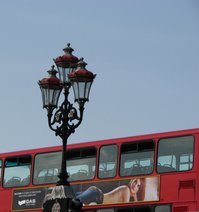As long as I can remember the name "Hackney" has conjured up all manner of horrors in my mind. Coming originally from a suburban and leafy part of the Midlands, London itself was scary enough. Crime was high, the pace was fast and the people uncaring- or at least that's how it felt to an outsider. Hackney along with such names as Tottenham and Brixton were virtual "no-go" areas to anyone visiting London from outside. They were like a British version of the Bronx.
Of course I now realise that London is not simply a city but a collection of a thousand villages. It can be as peaceful, as dangerous, as rich, as poor, as friendly or as sullen as the area you choose to visit or the time you go there. I've spent the last 15 years studying or working in or close to London so my vision of London through more rural eyes seems to almost belong to another lifetime.
Nonetheless, as any "Londoner" knows there is London and there is London. London is comprised of 33 boroughs ranging from the swanky millionaire ghetto that is Kensington and Chelsea, to leafy semi-rural towns with their own identity like Bromley to grittier areas like Barking and Dagenham.
Hackney definitely falls into the latter camp in most people's conceptions. Over the years it has become a byword for failing councils, high crime and urban poverty.
However like most generalised conceptions this does not show the full picture. Hackney has existed for hundreds of years, originally as a village outside London separated from the River Lea by marshes (now Hackney Marshes). In the Tudor period Hackney was a retreat for the nobility from London. As London grew it was subsumed into the city but offered many contrasts to the main urban area. On its eastern fringes large Victorian and Edwardian villas overlook Victoria Park. Hackney gave its name to horse-drawn Hackney carriages which originated there. The overused horses then lent their title to overused or tired phrases, hence "hackneyed expressions".
Modern Hackney was born in 1965 from the merger of the former metropolitan boroughs of Hackney, Shoreditch and Stoke Newington.
Today Hackney seems to be enjoying a renaissance. True, crime is relatively high but latest figures show this is falling sharply while it rises elsewhere. Hackney is also a borough of contrasts. To the north, the "murder mile" in Clapton well known for "black on black" shootings continues to be a scary place. However to the south trendy areas like Hoxton and Shoreditch border the City of London financial centre are now bristling with yuppie flats and artists. In the middle areas like Stoke Newington offer shopping bargains unfound elsewhere in London due to their slightly edgy reputation. Stamford Hill to the north remains home to many Orthodox jews who arrived as refugees in the 1930s.
Last weekend, Mrs. Donatella and I visited Broadway Market in Hackney. I had read about it and its interesting shops and Turkish hairdressers. Situated south of London Fields and to the north of the Regents Canal, it has a village feel and has obviously been discovered by a slightly off-putting group of trendy yuppies. That said it was not the gun-toting crime ridden image of Hackney I would have expected. Organic food stalls abounded overlooked by "real pubs" and hair salons. The main "business" was touted by pink-faced farmer like characters selling organic sausages rather than crack and more likely to be associated with Herefordshire than an inner-London borough. Nearby London Fields is a large green area from which the Gherkin and other City of London skyscrapers are visible little more than a mile or two away to the South.
Hackney lacks any London underground stations apart from on its borders although the Mainline from Liverpool Street stops there.
Hackney was refreshing. While it is increasingly being discovered, an edgy reputation ensures it is trendy without yet falling prey to the whims of the Waitrose classes. Hackney is independent and eccentric, it has a troubled recent past yet a long and distinguished history. It is one of the most ethnically diverse boroughs with only 44 % of residents calling themselves "white British" in the last census. Nonetheless, Hackney is an eye opener to the outsider with preconceived ideas. The 2012 Olympics which will be focused to the east of Hackney will bring wealth in. The variety and history of Hackney should combine to assure it a bright future.
I would encourage anyone to overcome their hackneyed view of Hackney.........
Wednesday, March 28, 2007
Overcoming a hackneyed view of Hackney
Subscribe to:
Post Comments (Atom)



No comments:
Post a Comment